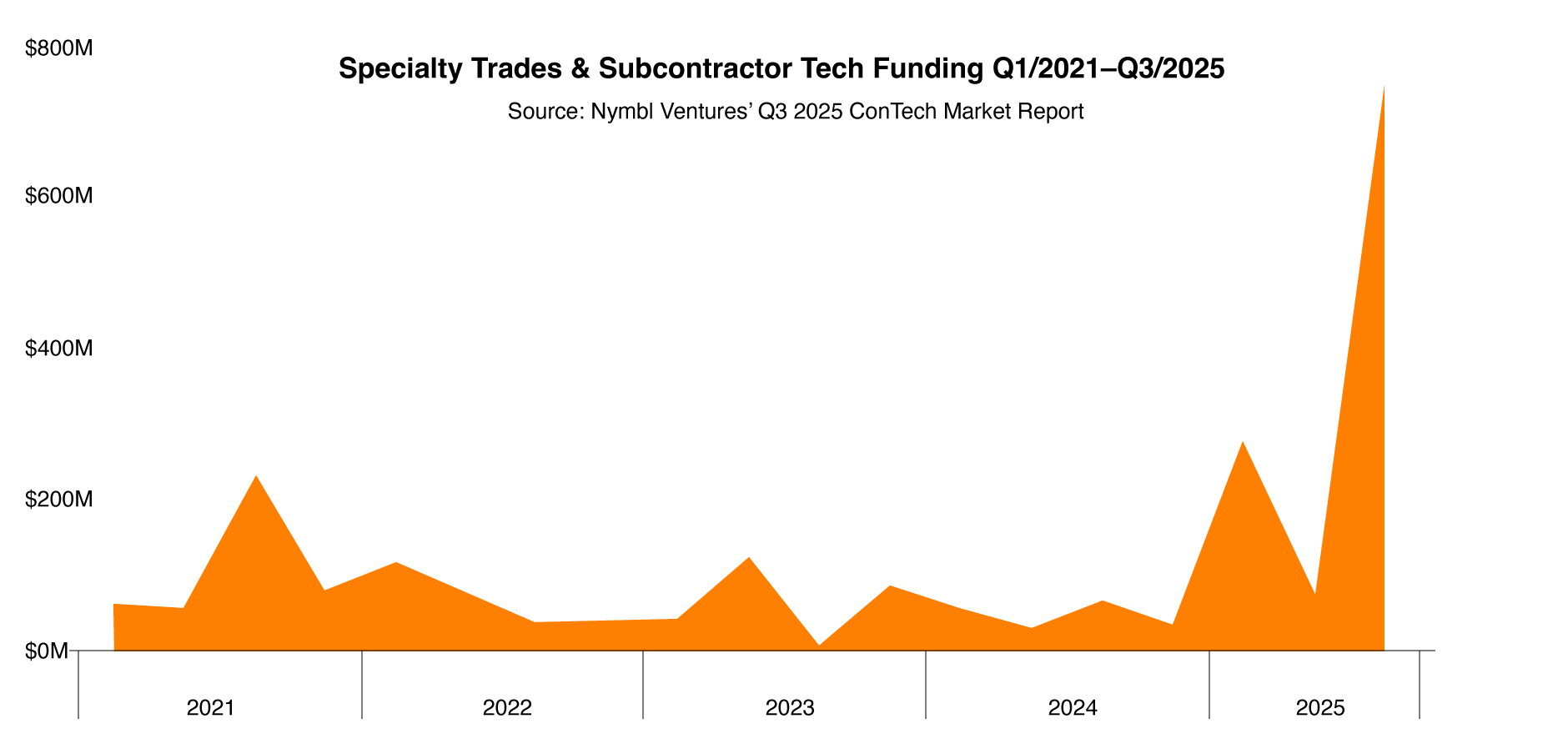If the seeds of tomorrow’s construction technology are sown today, what does the future look like? Nymbl Ventures’ Q3 2025 ConTech Market Report reveals interesting data on the ConTech scene.
A growth curve
First of all, Construction Tech (“ConTech”) is performing well compared to other built environment technologies. According to Nymbl, VC investment in the built environment increased by around 27% year-over-year through Q3 2025, with the ConTech category leading the way.
ConTech investments in the first three quarters totaled about $3.7 billion, more than twice the amount during the same period in 2024. Later-stage (post-Series A) deals accounted for 80% of funding in the third quarter. This suggests the market is moving from early experimentation to scaling and validating technologies in construction.
So, it seems that investors have found the ConTech sector and believe in its future potential.
Nymbl’s definition of ConTech: “All technologies involved in the construction of vertical and horizontal assets, and removed at the end of a project. (e.g., project management, field management, preconstruction solutions, workforce management, industrialized construction, insurtech, financing, architectural & engineering solutions, etc.)”
Focus shifting to specialty trades and subcontractors
General contractors have already adopted major project management and BIM platforms, which has turned the focus to smaller companies. These are the fragmented group trade and subcontractors, comprising nearly 5.24 million workers, around 63% of the US construction workforce.
Nymbl estimates that the addressable global market for this segment is $6.5 trillion.
The message to tech developers is to provide excellent usability, easy adoption, and tools that are friendly to trade at a scalable cost

AI, data, and robotics
Robotics has quietly taken a big chunk of ConTech investments. Since the start of 2025, robotics startups have raised $1.36 billion, a 125% YoY increase. This is 37% of all ConTech funding! However, 3D-printed construction remains a niche, with five deals raising $70M in new capital.
In my previous AEC Business newsletter, I wrote about humanoid robots. Nymbl’s numbers suggest that the robotic future might be closer than expected on construction sites.
AI is naturally high on investors’ shopping list, accounting for two-thirds of the sector’s investments, or $2.2 billion. AI needs data infrastructure and data management. Startups in that segment raised $1.66 billion across 51 deals.
Modular and prefab startups collected $319 million, well below the 2022 peak.
Longer lead-times for early-stage ConTech, but scale accelerates after proof
Fundraising cycles for ConTech startups take longer than equivalent in other built-environment tech. But once proven, growth accelerates, and the intervals between Series C and D are shorter.
ConTech startups encounter challenges in securing pilot customers, and the vital “proof period” can be long. This demands patience from investors, but the growth potential is considerable once industry validation happens.
Nymbl notes that corporate investor participation is on the rise. Another trend is that the startup ecosystem is consolidating. M&A strategy is becoming viable in ConTech.
Where’s the deployment data?
These startup and investor reports show one side of the story, but the other side is mostly missing. The industry still lacks a rigorous, statistically solid, and repeatable way to measure digital adoption and impact. Surveys often give conflicting results, even for something as simple as BIM usage. Most data relies on vague self-reporting and occasional case studies; helpful, but not enough to truly understand what’s happening on real projects.
The Nymbl report highlights that many ConTech startups are operating in emerging and unproven markets. Without deployment data, VCs are investing based on founder confidence, experimental pilots, and comparisons to other industries. It becomes hard to determine whether a market is early and gaining momentum, or early because the demand simply isn’t there.
Better data would benefit startups, too. It would reveal which workflows teams use most, where real value is created, and which features are unnecessary. This leads to clearer product–market fit, earlier adjustments, and fewer costly detours.
We’ve made significant advances in construction technology, and the investment signals are promising. However, we still lack a reliable understanding of how digital tools are used in everyday work. Until that gap is addressed, the industry will be building its future on incomplete information, creating a niche for someone to fill.
View the original article and our Inspiration here


Leave a Reply